Valencia |
|
|
|
| Übersicht – Contents: | |
Valencia |
|
|
|
| Übersicht – Contents: | |
Flagge – Flag: |
|
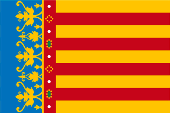 |
seit/since 1982, |
| historische und andere Flaggen – historical and other Flags: | |
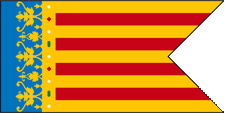 |
1377 bis/to 18. Jhd./century, |
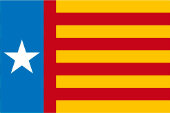 |
ab/from 19. Jhd./century, Senyera Estrelada, |
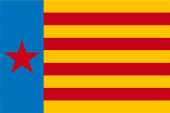 |
20. Jhd./century, Esquerra Valenciana, |
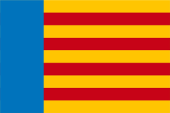 |
1978–1982, |
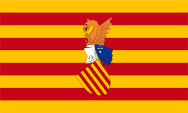 |
1979–1982, |
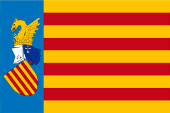 |
1982, |
 |
seit/since 1982, |
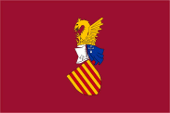 |
seit/since 1982, |
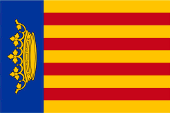 |
15. bis/to 18. Jhd./century, |
 |
seit/since 19. Jhd./century, |
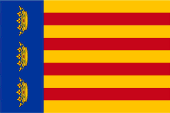 |
seit/since 15. Jhd./century, |
| Die heutige Flagge der Region Valencia (Comunidad Valenciana) wurde am 10.07.1982 als neue Flagge des Rates des Landes Valencia angenommen. Mit der Annahme des Autonomiestatus am 04.12.1984 wurde diese Flagge für die autonome Region Valencia übernommen. Diese Flagge geht auf die angebliche Flagge des Königreichs Valencia zurück. Sie zeigt die historischen und tatsächlich überlieferten vier roten Balken auf Gold, jedoch am Mast ein blaues Feld mit den Verzierungen der Krone von Aragon, abgetrennt von gestreiften Feld durch einen roten senkrechten Streifen, der als Teil der Krone zu verstehen ist. Das soll auf das Jahr 1377 zurückgehen, als König Peter IV., genannt der Feierliche, 1336–1387 König von Aragon und Valencia, der Stadt wegen ihrer Verdienste in den Peterskriegen die Erlaubnis erteilte, seine goldene Krone im Wappen zu verwenden. Seit dem erschien oberhalb des Wappens der Stadt die Krone. Wie wollte man das auf der Flagge darstellen? Hat man damals Königreich und überhaupt Stadt getrennt betrachtet? war es nicht ein Königreich mit dem Namen einer Stadt, mit der Stadt und ihrem Umland? Wenn man das so gelten lässt, dann war die Flagge der Stadt und des Königreichs, wie damals üblich, zunächst eine Wappenflagge. Das heißt, eine Flagge die das Bild des Wappens des Landes (eigentlich des Herrschers) zeigte. In dieser Frühzeit der Flaggen waren diese eigentlich auch nicht so geformt wie unsere heutigen Flaggen. Die Flaggen glichen eher Wappen, die man mit der geraden Seite am Mast befestigte. Darstellungen der Flagge mit der Krone auf blauem Grund in einem Feld der Flagge an Mast, finden sich erst ab dem 15. Jahrhundert. Das war wahrscheinlich nur eine Art Notlösung, denn wie wollte man sonst die über dem Wappenschild der Stadt schwebende Krone auf einer Flagge darstellen? Der Stadt Burriana erging es ähnlich, sie bekam sogar drei Kronen verliehen. Im Jahre 1707 wurde das Königreich Valencia in Folge des Spanischen Erbfolgekrieges abgeschafft und das Königreich in 3 Provinzen aufgeteilt, Valencia, Alicante und Castellón, wobei die Provinz Valencia das Wappen übernahm. Regional aufgeladene Besonderheiten verloren an Bedeutung, so dass sogar die Flagge in Vergessenheit geriet und für die Stadt eine neu weiße Flagge geschaffen wurde, welche die bourbonische Lilie in der Mitte zeigte. Danach existierte das Königreich nur noch nominell. Der im 19. Jahrhundert aufkommende Nationalismus lies regionale Besonderheiten wieder wichtig werden, auch in Valencia, so dass die Flagge mit den vier roten Balken auf Gold und dem blauen Feld mit den Verzierungen der Krone von Aragon als Flagge der Stadt und Region Valencia Verbreitung fand. Im Bereich der Politik fand sie sich als Kampfflagge, als politisches Symbol wieder, jedoch als Senyera Estrelada "Sternenhimmelflagge", ohne Krone, jedoch mit dem senkrechten roten Streifen. Anstelle der Krone erschien ein weißer fünfzackiger Stern. Die wichtigste nationalistische Partei war die Esquerra Valenciana, bei ihr zeigte Senyera Estrelada als Parteiflagge keinen senkrechten roten Streifen und der Stern war rot. Unter der der Regierung des Generals Franco (1936–1975) waren die meisten regionalen Flaggen verboten. Nach Francos Tod (1975) wurden dann regionale Flaggen wieder eingeführt, bzw. neue geschaffen. Für die sich langsam herausbildende Region Valencia wurde 1978 eine inoffizielle Flagge geschaffen, die auf die historische Flagge der Stadt Valencia mit dem blauen Feld und der Krone zurückging, jedoch auf die Darstellung der Krone selbst verzichtete. Der sich ebenfalls 1978 konstituierende Rat des Landes Valencia wählte sich 1979 die golden-rote Streifenflagge mit dem Wappen von König Peter IV. in der Mitte. Es entbrannte ein Streit um die Authentizität der Flaggen, als Kompromiss wurde eine Flagge vorgeschlagen, die im blauen Feld der Streifenflagge das Peterswappen zeigte. Er wurde verworfen und am 10.07.1982 wurde die heutige Flagge des Flagge Rates des Landes Valencia angenommen und 1984 für die autonome Region Valencia übernommen. |
The current flag of the
Region of Valencia (Comunidad Valenciana) was adopted on 10th of July in
1982 as the new flag of the Council of the Region of Valencia. With the
adoption of the autonomy status on 4th of December in 1984, this flag was
adopted for the autonomous region of Valencia. This flag goes back to the alleged flag of the Kingdom of Valencia. It shows the historical and actually handed down four red bars on gold, but on the mast a blue field with the decorations of the crown of Aragon, separated from the striped field by a red vertical stripe, which is to be understood as part of the crown. This is said to date back to 1377, when King Peter IV., called the Ceremonious, 1336–1387 King of Aragon and Valencia, granted the city the permission to use his golden crown in its coat of arms because of its merits in the Peter's Wars. Since then, the crown has appeared above the city's coat of arms. How was this to be depicted on the flag? Were the kingdom and the city considered separately at that time? Was it not a kingdom with the name of a city, with the city and its surrounding area? If you accept this, then the flag of the city and the kingdom was initially a heraldic flag, what was customary at the time. That is a flag that showed the image of the coat of arms of the country (actually the ruler). In the early days of flags, they were not actually shaped like our flags today. The flags were more like coats of arms, which were attached to the mast with the straight side. Depictions of the flag with the crown on a blue background in a field of the flag on the mast are only found from the 15th century onwards. This was probably just a kind of makeshift solution, because how else could the crown floating above the town's coat of arms be depicted on a flag? The town of Burriana fared similarly, and was even awarded three crowns. In 1707, the Kingdom of Valencia was abolished as a result of the War of the Spanish Succession and the kingdom was divided into 3 provinces, Valencia, Alicante and Castellón. The province of Valencia took over the coat of arms. Regionally charged characteristics lost their importance, so that even the flag was forgotten and a new white flag was created for the city, which showed the Bourbon lily in the centre. After this, the kingdom only existed nominally. The rise of nationalism in the 19th century meant that regional specialities became important again, including in Valencia, so that the flag with the four red bars on gold and the blue field with the decorations of the crown of Aragon became widespread as the flag of the city and region of Valencia. In the political sphere, it was used as a battle flag, as a political symbol, but as the Senyera Estrelada "starry sky flag", without a crown, but with a vertical red stripe. A white five-pointed star appeared in place of the crown. The most important nationalist party was the Esquerra Valenciana, whose Senyera Estrelada flag did not have a vertical red stripe and the star was red. Under the government of General Franco (1936–1975), most regional flags were banned. After Franco's death (1975), regional flags were reintroduced or new ones were created. In 1978, an unofficial flag was created for the slowly emerging region of Valencia, which was based on the historical flag of the city of Valencia with the blue field and the crown, but without the depiction of the crown itself. The Council of the Region of Valencia, which was also constituted in 1978, chose the gold and red stripe flag with the coat of arms of King Peter IV in the centre in 1979. A dispute arose over the authenticity of the flags, and a compromise was proposed: a flag showing the coat of arms of Peter in the blue field of the stripe flag. It was rejected and on 10th of July in 1982, the current flag of the Flag Council of Valencia was adopted and in 1984 it was adopted for the autonomous region of Valencia. |
| Quelle/Source: 1. Wikipedia (CA), 2. Wikipedia (CA), 3. Wikipedia (CA), World Statesmen, Volker Preuß | |
Wappen – Coat of Arms: |
|
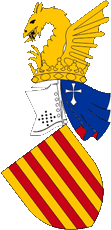 |
seit/since 1982, Wappen der Comunidad Valenciana – coat of arms of the Comunidad Valenciana, Quelle/Source, nach/by: Wikipedia (CA) |
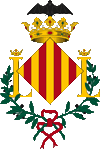 |
seit/since 1377, Wappen der Stadt Valencia – coat of arms of the City of Valencia, Quelle/Source, nach/by: Macondo, CC BY-SA 4.0, via Wikimedia Commons |
historische Wappen – historical Coats of Arms: |
|
 |
14./15. Jahrhundert – 14th/15th century, Wappen des Königreichs Valencia – coat of arms of the Kingdom of Valencia, Quelle/Source, nach/by: Wikipedia (CA) |
 |
14. Jahrhundert – 14th century, zeitweise/alternativ – temporarily/alternatively, Wappen von Valencia – coat of arms of Valencia, Quelle/Source, nach/by: Wikipedia (CA) |
| Das heutige Wappen der Region Valencia (Comunidad Valenciana) wurde bereits am 17.06.1978 neu festgelegt, damals noch als Wappen des Rates des Landes Valencia. Mit der Annahme des Autonomiestatus am 04.12.1984 wurde dieses Wappen für die autonome Region Valencia übernommen. Es geht zurück auf König Peter IV., genannt der Feierliche, 1336–1387 König von Aragon und Valencia, der es erstmals verwendete. Mit geringfügigen Veränderungen wurde es bis zu König Johann II., 1458–1479 König von Aragon und Valencia, weiter genutzt. Es zeigt das geneigte Wappen der vereinigten Krone von Aragonien mit vier roten Balken auf Gold, darüber einen silbernen, golden bekrönten Helm mit einer blauen Helmdecke und einem Silbernen Arista-Kreuz darauf. Helmzier ist ein geflügelter goldener Drache. Der geflügelte Drache war für die Region wichtig und erscheint auf vielen Gemeindewappen, jedoch hat er sich über die Jahrhunderte bis hin zu einer Fledermaus verändert. Im Jahre 1707 wurde das Königreich Valencia in Folge des Spanischen Erbfolgekrieges abgeschafft und das Königreich in 3 Provinzen aufgeteilt, Valencia, Alicante und Castellón, wobei die Provinz Valencia das Wappen übernahm. Danach existierte das Königreich nur noch nominell. |
The current coat of arms
of the Region of Valencia (Comunidad Valenciana) was established on 17 June
1978, when it was still the coat of arms of the Council of the Region of
Valencia. With the acceptance of the autonomous status on 4 December 1984,
this coat of arms was adopted for the autonomous region of Valencia.
It goes back to King Peter IV., called the Ceremonious, King of Aragon and Valencia from 1336 to 1387, who used it for the first time. With minor changes, it continued to be used until King John II., King of Aragon and Valencia from 1458 to 1479. It shows the inclined coat of arms of the united crown of Aragon with four red bars on gold, above a silvery helmet crowned in gold with a blue helmet cover and a silvery Arista cross on it. The crest is decorated with a winged golden dragon. The winged dragon was important for the region and appears on many municipal coats of arms, but it has changed over the centuries to a bat. In 1707, the Kingdom of Valencia was abolished as a result of the War of the Spanish Succession and the kingdom was divided into 3 provinces, Valencia, Alicante and Castellón. The province of Valencia took over the coat of arms. After that, the kingdom only existed nominally. |
| Quelle/Source: Wikipedia (CA), Volker Preuß | |
|
Die autonomen Regionen Spaniens – The autonomous Regions of Spain: Interaktive Landkarte - interactive map |
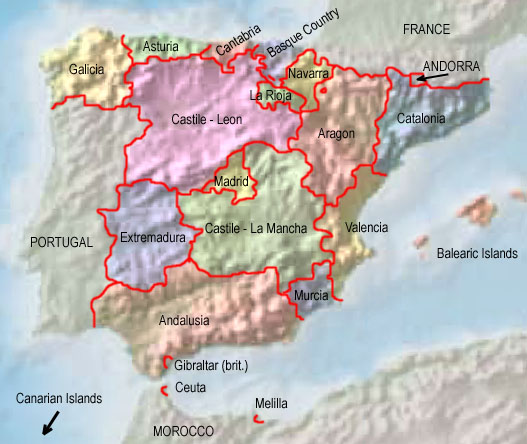 |
| Quelle/Source: Freeware, University of Texas Libraries, modyfied by: Volker Preuß |
| Zahlen und Fakten – Numbers and Facts: | |
|
|
|
|
|
|
|
|
|
|
|
|
|
|
|
Frühzeit
· Besiedlung durch Iberer ca. 600 v.Chr. · Einwanderung von Kelten, Vermischung mit den Iberern, Herausbildung der Keltiberer, Gründung der griechischen Kolonie Turia (das spätere Valencia) 218–201 v.Chr. · Zweiter Punischer Krieg, das Römische Reich erwirbt die Besitzungen Karthagos in Iberien, Unterwerfung der ganzen Iberischen Halbinsel bis zum Jahre 19 v.Chr. 217 v.Chr. · die Region des heutigen Valencia kommt zur römischen Provinz Hispania Tarraconensis, römische Besiedlung, Romanisierung 138 v.Chr. · Gründung von Valentia durch D. Brutus, Ansiedlung von Lusitaniern, ein keltisches Volk aus der Region des heutigen Portugal ca. 400 n.Chr. · Völkerwanderung, Durchzug von Alanen, germanischen Sweben und Westgoten 415 · zum Westgotenreich 714 · die Araber erobern die Region Valencia, die Stadt wird in "Medina bu Taral" umbenannt, Arabisierung, Islamisierung, Valencia wird Provinz des Emirates von Cordoba (ab 929 arabisches Kalifat Cordoba unter der Dynastie der Omajjaden) 1010 · Sturz der Omajjaden-Dynastie, bis 1040 zerfällt das Reich in mehrere arabische Königreiche (Malaga, Algeciras, Granada, Cordoba, Toldeo, Valencia, Zaragoza, Denia, Murcia und Badajoz) 1031 · Muzeik, der arabische Statthalter von Valencia, macht das Königreich Valencia von Cordoba unabhängig 1094 · der legendäre kastilische Nationalheld El-Cid (el Campeador, eigentl. Rodrigo Díaz de Vivar, 1043–1099) erobert und befreit Valencia 1099 · El-Cid stirbt in Valencia, die Stadt wird wieder von den Arabern erobert 1238 · König Jakob I. von Aragonien befreit Valencia erneut von den Moslems, Gründung der Grafschaft Valencia 1319 · Valencia wird mit Aragonien, Katalonien und den Balearen unter der vereinigten Krone von Aragonien vereinigt 1469 · Heirat von König Ferdinand II. von Aragon mit Isabella, der Thronerbin von Kastilien 1479 · Krönung von Ferdinand II. und Isabella I. zu Königen von Spanien 1516 · offizielle Vereinigung von Aragonien und Kastilien, Aragonien behält jedoch wichtige Privilegien 1609 · König Philipp III. von Spanien verweist die letzten Moslems (Moresques) des Landes 1701–1714 · Spanischer Erbfolgekrieg, Aragonien ergreift für Östrereich Partei, 1706 erfolglose Landung britischer und niederländischer Truppen, nach der Niederlage der österreichischen Partei, 1707 Ende des selbstständigen Königtums der Vereinigten Krone von Aragonien, Verlust der Privilegien, Katalonien, die Balearen und Valencia werden als spanische Provinzen ausgegliedert, Aragonien (in seinen heutigen Grenzen), und Valencia behalten nominell den Titel eines Königreichs, Katalonien wird nominelles Fürstentum Barcelona, das Königreich Valencia wird aufgeteilt in die Provinzen Alicante, Valencia und Castellón de la Plana 1808–1811, 1812–1813 · Valencia ist durch französische Truppen besetzt 1833 · die bis dato in Spanien bestehenden Teilkönigreiche und Regionen werden in Provinzen aufgeteilt 1931–1939 · Valencia hat das Autonomiestatut innerhalb Spaniens 1936–1939 · Spanischer Bürgerkrieg, Valenica kämpft – vor allem im Süden – bis 1939 auf Seiten der sozialistischen Regierungstruppen 10.07.1982 · Valencia erhält das Autonomiestatut innerhalb Spaniens (unter Zusammenfassung der Provinzen Alicante, Valencia und Castellón de la Plana), Gründung der "Autonomen Gemeinschaft Valencia" |
|
early age · settlement by Iberians ca. 600 B.C. · immigration of Celts, mix with the Iberians, evolution of the Celtiberians, establishment of the greek colony of Turia (the later Valencia) 218–201 B.C. · Second Punic War, the Roman Empire acquires the possessions of Carthago in Iberia, subjugation of whole Iberia until the year 19 B.C. 217 B.C. · the today’s Catalonia comes to the Roman province of Hispania Tarraconensis, Roman settlement, romanization 138 B.C. · foundation of Valentia by D. Brutus, directed settlement of Lusitanians, a Celtic people from the region of the today’s Portugal ca. 400 A.D. · Great Transmigration (Migration Period), immigration of teutonic Alans, Suebs and Western Goth 415 · to the Empire of the Western Goth 714 · Arabs conquer the region of Valencia, the town gets the name "Medina bu Taral", Arabization, Moslemization, Valencia becomes a province of the Emirate of Cordoba (since 929 Arabian Califate of Cordoba under the dynasty of the Omajjads) 1010 · overthrow of the Omajjads dynasty, to 1040 disintegrates the empire in some arabian kingdoms (Malaga, Algeciras, Granada, Cordoba, Toldeo, Valencia, Zaragoza, Denia, Murcia and Badajoz) 1031 · Muzeik, the arabian proconsul of Valencia, makes the Kingdom of Valencia independent from Cordoba 1094 · the legendary castile national hero El-Cid (el Campeador, really: Rodrigo Díaz de Vivar, 1043-1099) conquers and liberates Valencia 1099 · El-Cid dies in Valencia, the town becomes conquered again by the Arabs 1238 · king Jakob I. of Aragon liberates Valencia again from the Muslims, establishment of the County of Valencia 1319 · Valencia becomes united with Aragon, Catalonia and ten Balearic Islands under the United Crown of Aragon 1469 · marriage of king Ferdinand II. with Isabella, the throne heiress of Castile 1479 · coronation of Ferdinand II. and Isabella I. to kings of Spain 1516 · official unification of Aragon and Castile, but Aragon withholds important privileges 1609 · king Philipp III. of Spain banishes the last Muslims (Moresques) out of the country 1701–1714 · Spanish succession war, Aragon positiones itself at the side of Austria, in 1706 unsuccessful debarkation of British and Dutch troops, after the defeat of the Austrian Part end of the independent kingship of the United Crown of Aragon in 1707, loss of the privileges, Catalonia, the Balearic Islands and Valencia become outsourced as Spanish provinces, Aragon (in its today's borders) and Valencia withhold nominally the title of a kingdom, Catalonia becomes nominally the Principality of Barcelona, the Kingdom of Valencia is divided in the provinces of Alicante, Valencia and Castellón de la Plana 1808–1811, 1812–1813 · Valencia is occupied by French troops 1833 · the until that point in time in Spain existing partial kingdoms and regions become divided in provinces 1931–1939 · statute of autonomy for Valencia within Spain 1936–1939 · Spanish Civil War, Valenica fights – especially in the south – until 1939 on the side of the socialistic governmental troops 10th of July 1982 · Valenica gets the statute of autonomy within Spain (by summary of the provinces of Alicante, Valencia and Castellón de la Plana), establishment of the "Autonomous Community of Valenica" |
| Quelle/Source: Wikipedia (ES), World Statesmen, RetroBib Retrobibliothek, Volker Preuß |
| Der Name der Stadt und Region Valencia geht auf die römische Kolonie Valentia zurück. Im Jahre 138 v.Chr. wurde die Stadt als römische Kolonie von D. Brutus neu belebt und Valentia genannt. Das Wort "Valentia" geht auf das lateinische Wort "valens" zurück, was "gesund, kräftig oder munter" heißt. Valentia ist also "die Gesunde". |
The name of the city and the region of Valencia has its roots in the Roman
colony of Valentia. In the year 138 B.C. the city was revitalized as Roman colony by D. Brutus and it was named Valentia. The word "Valentia" has its roots in the Latin word "valens" what means "healthy, strong or lively". Valentia is in this way "the Healthy". |
| Quelle/Source: Handbuch der geographischen Namen | |